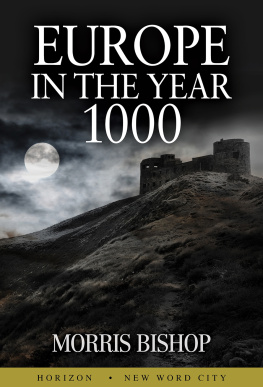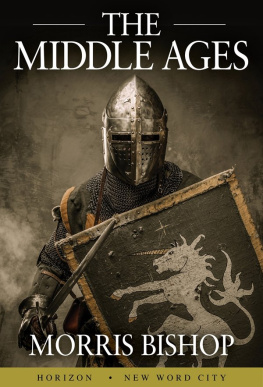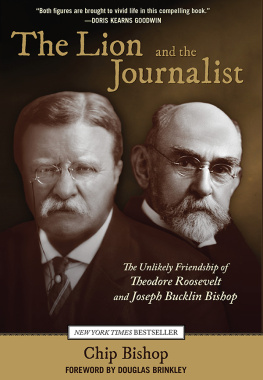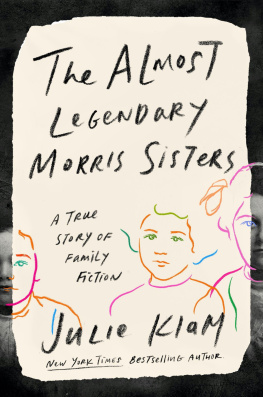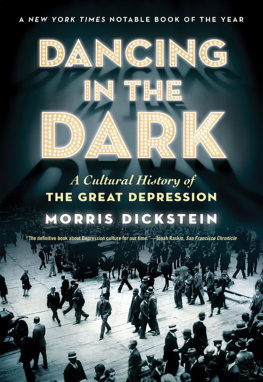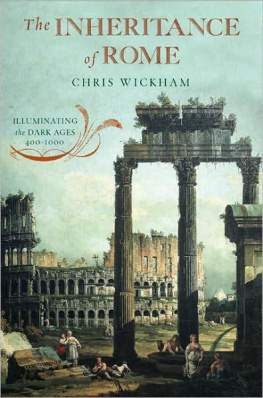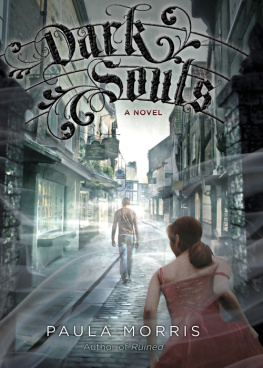Morris Bishop - Europe in the Year 1000
Here you can read online Morris Bishop - Europe in the Year 1000 full text of the book (entire story) in english for free. Download pdf and epub, get meaning, cover and reviews about this ebook. year: 2016, publisher: New Word City, Inc., genre: Religion. Description of the work, (preface) as well as reviews are available. Best literature library LitArk.com created for fans of good reading and offers a wide selection of genres:
Romance novel
Science fiction
Adventure
Detective
Science
History
Home and family
Prose
Art
Politics
Computer
Non-fiction
Religion
Business
Children
Humor
Choose a favorite category and find really read worthwhile books. Enjoy immersion in the world of imagination, feel the emotions of the characters or learn something new for yourself, make an fascinating discovery.
- Book:Europe in the Year 1000
- Author:
- Publisher:New Word City, Inc.
- Genre:
- Year:2016
- Rating:4 / 5
- Favourites:Add to favourites
- Your mark:
- 80
- 1
- 2
- 3
- 4
- 5
Europe in the Year 1000: summary, description and annotation
We offer to read an annotation, description, summary or preface (depends on what the author of the book "Europe in the Year 1000" wrote himself). If you haven't found the necessary information about the book — write in the comments, we will try to find it.
A millennium ago, our forebears lived in a Dark Age. They themselves did not think it was dark, and they were only half wrong. Here, in this essay from New York Times bestselling historian Morris Bishop is the story of Europe in the year 1000.
Europe in the Year 1000 — read online for free the complete book (whole text) full work
Below is the text of the book, divided by pages. System saving the place of the last page read, allows you to conveniently read the book "Europe in the Year 1000" online for free, without having to search again every time where you left off. Put a bookmark, and you can go to the page where you finished reading at any time.
Font size:
Interval:
Bookmark:
Let us fix our gaze on the state of Western Europe over a millennium ago in CE 1000. What was our world like? And what were its inhabitants, the forbearers of many of us, like?
Look first to the east to the Russian steppes. There, the Slavs dwelt and pushed ever westward. Their flourishing towns, Kiev and Novgorod, rivaled the best in Western Europe. The Bulgarians moved into their Bulgaria. The Poles thrust out of Russia to their present home, where, in 966, their duke, Mieszko, was baptized a Roman Catholic, and all his people, by his order, were converted overnight. The Hungarians, a people from beyond the Urals, appeared in the West at the end of the ninth century. They ravaged and looted as far as Burgundy, but defeated by the German Otto the Great in 955, they settled down in their new homeland and became peaceful farmers and devout Roman Catholics. Theirs was the last serious barbarian invasion of Europe, for the rampaging fourteenth-century Turks were hardly barbarians. Henceforth the barbarous foe was to come not from beyond eastern borders but from underneath.
Constantinople was the capital of the Eastern Empire, a centralized state with an efficient standing army, a competent bureaucracy, subsidized schools and hospitals, a sophisticated art and literature fostered by the Orthodox Eastern Church. A Western envoy to Constantinople in 949 was bedazzled by the emperor, richly jeweled, sitting on a golden throne beside a bronze tree with twittering bronze-gilt birds. He was guarded by gigantic lions. His throne could be elevated on high like a garage lift.
Islam ruled from India to Spain, but by the tenth century, it lost its expansive impetus and settled down to the enjoyment of its culture and gracious living. In Spain, under the Ommiad dynasty, living could be gracious, indeed. The land was irrigated and bloomed like a garden, yielding rice, sugarcane, cotton, citrus fruits, as well as wheat and olives. Innumerable workshops produced arms, leather and silk goods, carpets, textiles, and pottery for export as far as China. The capital, Crdoba, boasted a half-million residents, 700 mosques, many Christian churches and Jewish synagogues, 300 public baths, a 400,000-volume library, and a university with courses in mathematics, astronomy, theology, philosophy, medicine, and law. At the time, there were no universities in Latin Christendom.
Arab physicians were famed throughout the West. Poets and poetesses abounded. Their romantic love songs, with their cult of the inaccessible lady, deeply affected the later Provenal troubadours, and through them, our modern conventions of wooing in verse and music. The Arabs were passionate sportsmen, delighting in archery, polo, horse racing, hunting, hawking, tennis, and croquet. They delighted, too, in festive parties with singers and abundant wine. (The wine was, of course, prohibited by law, but there was no lack of Christian and Jewish bootleggers.)
By comparison, the Christian West was mostly wild country, repossessed by the dark forest, the home of wolves, bears, wild boars, and aurochs, the ancestor of domestic cattle. It also was the home of outlaws and robbers and of gnomes and goblins guarding once-sacred trees and springs. Here and there were the marks of abandoned cultivation, hummocks hiding forgotten towns and lost cities, the dwellings of evil pagan ghosts.
The Roman remains - the broken aqueducts and overgrown amphitheaters - seemed the work of giants. Old Roman roads marched unswerving over hill and dale, but roots and bushes pried their stones apart, and many of the old stone-arched bridges had fallen into the streams. The inhabitants were unconcerned; the broken highways discouraged invaders. Overhanging it all was a sense of ruin, of descent from a greater and happier past. Here was the Dark Age, as modern historians, in their misplaced pride, termed it.
In 909, a Church synod reported with sober justice: The towns are depopulated, the monasteries ruined and burned, the good land converted into desert. Just as primitive men lived without rule and without the fear of God, subject only to their own passions, so today everyone does what he pleases, in scorn of human and divine laws and the commandments of the church. The strong oppress the weak; the world is filled with violence toward the defenseless, and men pillage the churchs property. Men devour one another like the fishes of the sea.
True enough, but it is always darkest before the dawn. By 973, matters had improved. The savage Vikings had been bought off by the grant of Normandy as a homeland, and they, like the Hungarians, came to prefer farming to plunder and Christian doctrine to the service of bloodthirsty gods. Arab pirates still roved the Mediterranean; they were established on the French Riviera. From Alpine passes, one of which is still known as Monte Moro, they raided northward, attacking even the Swiss monastery of Saint Gall in 954. In the year 972, they took captive and held for enormous ransom the Abbot of Cluny as he was crossing the pass of Great Saint Bernard out of Italy. This indignity provoked the count of Provence to wipe out the pirate nests and drive the Arabs back across the sea.
There were other alleviations in life in the tenth-century world. Few plagues and epidemics are reported. Neglected land was brought back into cultivation; new agricultural techniques improved the yield of thin, exhausted fields. The population grew with an increase in food production but at a faster rate. Research by Professor Lynn White of the University of California at Los Angeles attributed the increases to a new profusion of proteins in the form of broad beans, peas, chickpeas, and lentils. There were similar population explosions in China, the Mideast, and the Scandinavian north.
The Western world of 1000 was fragmented, a bundle of localisms. England, to be sure, enjoyed a brief cohesion under Edgar the Pacific (959-975). But Edgar died young, and troubles aplenty awaited his successors, including Ethelred the Unready, or the Stupid.
France was a collection of baronies and dukedoms, mutually hostile, united chiefly by opposition to their king. The nominal king of France was Lothair, next-to-last of the line of Charlemagne; he ruled precariously over Paris and the le-de-France.
Italy was a power vacuum. The north was a congeries of nearly independent city-states, imperial fiefs, and bishoprics wielding temporal rule. Rome and the surrounding Papal States were the property of the Church. Calabria and Apulia, the heel and the tip of the boot, belonged to the Eastern Empire in Constantinople. Sicily was under Islamic rule.
Only in Germany was there something approaching national unity, under Otto I. Duke of the Saxons and king of the East Franks, he checked the invading Hungarians, Slavs, and Danes, fostered the Christian faith, and made an alliance with Byzantium. In 962, he revived the Roman Empire, with himself as emperor. In 973, his son Otto II became emperor. But the empire was hollow; it had no imperial administration and little control over the mighty dukes, barons, and prelates of Germany.
A good share of the fragmented world was precariously ordered by the social-governmental-economic system of feudalism. The word itself has unfairly been tarred with ugly connotations. The feudal system arose in response to needs - the need of the poor for protection and the need of the strong for soldiers and for upkeep of their strength. Feudalism was a bargain. The poor exchanged freedom for security, for they would rather be safe than free, and anyway, freedom meant little when there was no place to go and nothing to do when one got there.
Feudalism had its elevated doctrine, its ethos of loyalty, courage, and honor. The feudal lord was not necessarily an oppressor. The system was at its best a workable one, based on land and the lands products, not on money. If serfs were bound to the land, the land was bound to them; they could not be dispossessed and driven into an unwelcoming world. Feudalism encouraged a certain peace of mind. Every persons status was fixed, his or her destiny and duties clear.
Next pageFont size:
Interval:
Bookmark:
Similar books «Europe in the Year 1000»
Look at similar books to Europe in the Year 1000. We have selected literature similar in name and meaning in the hope of providing readers with more options to find new, interesting, not yet read works.
Discussion, reviews of the book Europe in the Year 1000 and just readers' own opinions. Leave your comments, write what you think about the work, its meaning or the main characters. Specify what exactly you liked and what you didn't like, and why you think so.

